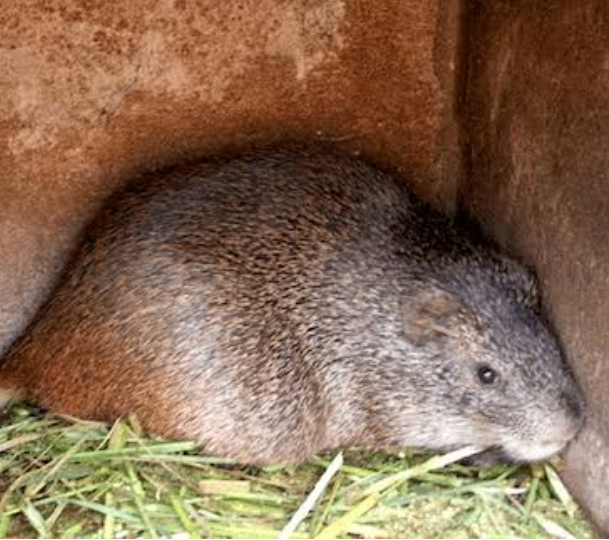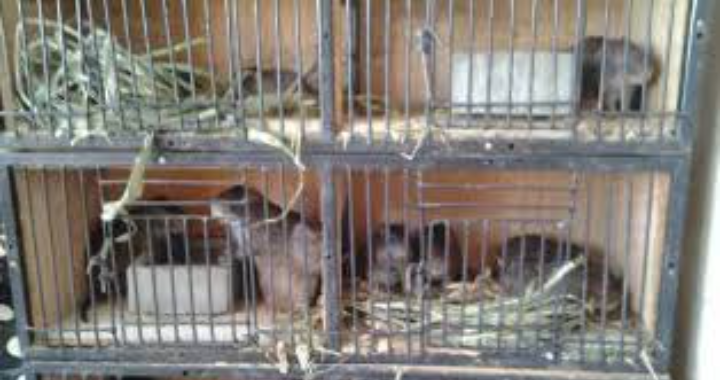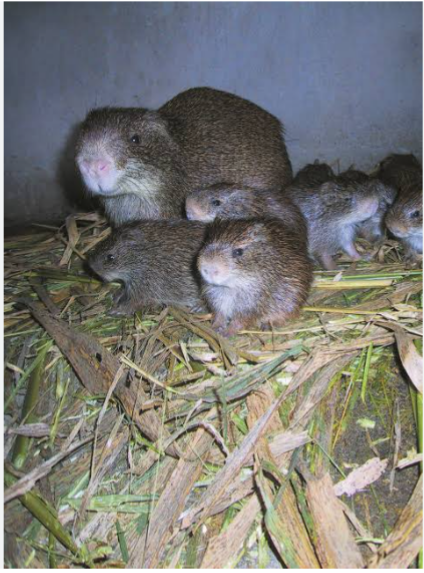
Grasscutter is a microlivestock and its scientific name is Thryonomys species. Grasscutter is also known or called cutting grass or cane rat. They are monogastric (one-stomach) animal and they feed on plants and plant produce( herbivore).
They are harmless, live in groups (in colonies). Two mature males don’t live together. A colony do consist of one male and three to four females. They do not burrow into the soil but can use holes dug by animals.
Grasscutter is adaptable to most tropical vegetation especially in West Africa . They are found in mangroves, swamps, rainforests and savannas. They are usually found in farmlands, sugarcane plantations, oil palm plantations and in creeks. They are more active at night ( they are nucturnal animal). This is due to the biology of their eyes.
In captivity, the nucturnal nature have effect on them. This can be noticed in their inability to feed during the day but gradually, they get adapted to the bright light. Adaptability to bright light takes about 100 days.
In Nigeria, grass cutter farming is on the rise. Yoruba tribe called it Oya. Hausa call it Gafia (Gouza or Guahia) and Igbo call it Nchi. It provide employment and a good source of income for people. It’s meat is acceptable to most religion and societies. Compared to other meats such as rabbit meat, grasscutter meat is very low in cholesterol and high in protein. It has a very high mineral (e.g. iron, calcium and phosphorous) content compared to beef, mutton, and chevon. The economic return on rearing is comparable to that of a cow, much higher than most livestock species, and only lower than that of the pig. It is very easy, cheap to start and maintain, grasscutter farming is said to be a highly profitable business in animal farming.
SPECIES OF GRASS CUTTER
There are two species of grass cutter
1. Thryonomys swinderianus
2. Thryonomys guegorianus
HOW TO CAPTURE GRASS CUTTER IN THE WILD
The method used to capture grass cutter in the wild is the chase and grip method. It involves able men who will surround the located home of the rat. As the house is disturbed, they run out of the hole and they are caught.
GRASSCUTTER MEAT
Grass cutter farming is a very lucrative business. Most people in the city can not buy the meat of grasscutter because it’s very scarce, so no amount of Grasscutter produced that can’t be sold within days. It will take combined efforts of thousands of farmers to fill the need for bush meat in the market in Africa right now. Grasscutter meat or Bush meat is probably the most desirable animal meat in the market. Everyone loves it and it sells very fast. Big restaurants uses it to prepare high priced delicacies.
HANDLING METHOD
When gripping the animal, the left hand should be used to hold the neck, while the right hand is used to support the animal on their loin.
HOUSING SYSTEM

Grass cutter are raised in pen/cages. The size of the cage should be tailored to fit the size of the grasscutter. Also, trays for feeding and drinking should be made heavy so that the grasscutters cannot displace them. The material used for the pen can be metals, hard wood, and concrete. Hard wood usage prevent the animals from chewing the wood. The pen must be constructed in a way that it will have a room and parlour linked together. This is due to the wild nature in their livelihood. The dimension of the parlour and room should be 1 metre in length, 0.5 metres in breath and 0.5 metres in height.
FACTORS TO CONSIDER IN CONSTRUCTION OF THE PEN
1. A room and parlour should be provided
2. Grass cutter are subject to pneumonia. This is a deadly disease. Therefore, the floor of the pen should be raised.
3. Each pen should be constructed to have a separate door either on the side or on top of the pen
FEEDING HABIT
From the name grass cutter, which is familiar to grasses, grass constitute their major diet. Not all grasses are prefered by the animal. Grasses such as :
Sugarcane (Saccharum officinarum)
Gamba grass (Andropogin gayanus)
Elephant grass(Pennisetum purpureum)
Guinea grass (Panicum maximum) etc
are prefered
The tree grasses have a robust stem, with juicy fluid suitable to the rats taste. This gives reason why grass cutter drink less water. Apart from grasses, they also feed on tubers like potatoes, and cassava but do not eat yam. Cereals such as corn, dried grains (not wet), concentrates. Feeding with concentrate will supply them with more nutrients and balance their diet. Some concentrates are made of only one ingredient. This would not give the animals all the nutrients they need so it should be rotated with other feeds. Other concentrates are made from multiple ingredients and can be fed to the grasscutters constantly. The feed should be placed in the feeding container and not the floor to prevent the grasscutters from soiling the feed with there faeces. Grasscutters can be fed two or three times daily. Feeding the grasscutters should be consistent every day meaning, If the farmer feeds them in the afternoons by 2 pm, he should keep up with that time.
When fed with dried grains and concentrates, much water should be provided for drinking. Without the water, they would develop constipation which may lead to their death.
A drinker and feeding trough should be provided per pen. A baby grasscutter depends on the mother for milk. And when it is about 6 weeks old, it is ready to be weaned.
REPRODUCTION IN GRASS CUTTER

-Gestation period : – – 152 days (5 months)
-Sexual maturity period :- – 7 to 8 months
-Weaning period :- – 8 weeks
-Litter size :- – 8 to 10 litters in commercial farms
Grass cutter are polygamous in nature. They are fast reproducing animal and starts mating within 7 months after birth. The female gives birth twice yearly and produce 4-10 young ones at a time. That means, if a farmer has 100 females that gives birth twice in a year, he would be having 900 to 1,500 grasscutter in his farm within just a year. Such number bring good income when they are matured for marketing.
A male can service/mate 4 females (5 grass cutter are housed together). The five animals should be housed together until they have mated and given birth before separation can occur
The baby grass cutter have the following characteristics
1. It has two pair of incisor in its mouth
2. Immediately the baby is given birth to, it’s eyes are open
3. It possesses fur
4. It has ability to run
5. It can breast feed
If baby grass cutter are not weaned after 8 weeks, they would harm the mother by eating her teat.
After weaning, the young can be fed with grasses
PREGNANCY SIGNS
1. The female will be sleeping more than necessary
2. She will be snoring
3. She will lie down on her back
4. The stomach begins to swell around third to fourth month
SEXING
1. The male grass cutter has a large head with broad muzzle. While the female has pointed muzzle
2. The female has three pairs of mammary gland below her abdominal region covered with fur
3. The urinogenital organ of the female grass cutter is very close to her a us while that of the male is spacious away from the anus
DISEASES AND TREATMENT
Grasscutters are susceptible to a number of diseases and parasites, including: Pneumonia, Gastrointestinal helminths, respiratory diseases, coccidiosis, zoonotic diseases etc
1. RESPIRATORY DISEASES OR PNEUMONIA: These can account for up to 29.19% of diseases in grasscutters. Grasscutter Pneumonia is caused by the bacterium Diplococus pneumonate and it is a common occurence during cold weather.
Treatment : Give antibiotics and multivitamins and always ensure warmth in the Grasscutter housing.
2. BRONCHOPULMONARY DYSPLASIA : This is also a respiratory disease in Grasscutter. It is a condition that occurs after birth, usually as a result of mechanical ventilation and oxygen use. It’s characterized by inflamed and damaged alveoli and lung vasculature
3. ZOONOTIC DISEASES: These include trypanosomiasis, babesiosis, plasmodiasis, and leptospirosis. They are caused by parasites.
4. COCCIDIOSIS: This disease is caused by protozoa of the Eimeria family. It showns symptoms of Bloody diarrhoea, Loss of appetite, weaknesses and isolation. Prevention and treatment: Adhere to strict biosecurity, maintain adequate hygiene and avoid contact with wet litter to prevent the disease. Treatment: Isolate sick individuals and administer coccidiostat in their water
5. ENTEROTOXAEMIA: This is a bacterial disease caused by the bacterium, Clostridium perfringes. The symptoms include; paralysis and pedaling of the hind legs. Prevention: Vaccination and keep the environment clean
6. STAPHYLOCOCEAMIA: This disease is caused by the bacterium- Staphylococcus aureus. It shows symptoms of discharge from the nostrils and vagina, Coughing. Prevention: Avoid exposure to cold and avoid exposure to smoke. Treatment: Use LA antibiotics
PARASITES OF GRASSCUTTER. Parasites ( both endo and ecto) are a major challenge in Grasscutter farming. The infestation may be from the feeding of: Wet contaminated grass foliage of sugarcane. And. Damp litter/beddings.
1. GASTROINTESTINAL HELMINTHS: These are worms such as Ascaris spp., Trichostrongylus spp, Fasciola spp, Schistosoma spp, Taenia spp, and Acanthocephalan spp. that cause diseases
2. HAEMOPARASITES: The parasites include Trypanosoma, Babesia, and Plasmodium species that cause diseases to the animal. PREVENTION• Change litter regularly • Avoid feeding of wet forage
TREATMENT• Regular deworming should be carried out to get rid of worms. Also Dipping in acaricide can help solve problems of ectoparasites.
PESTS
Grasscutters can also be threatened by predators and pests, such as snakes, birds of prey, wild cats, mites, ticks, and fleas
